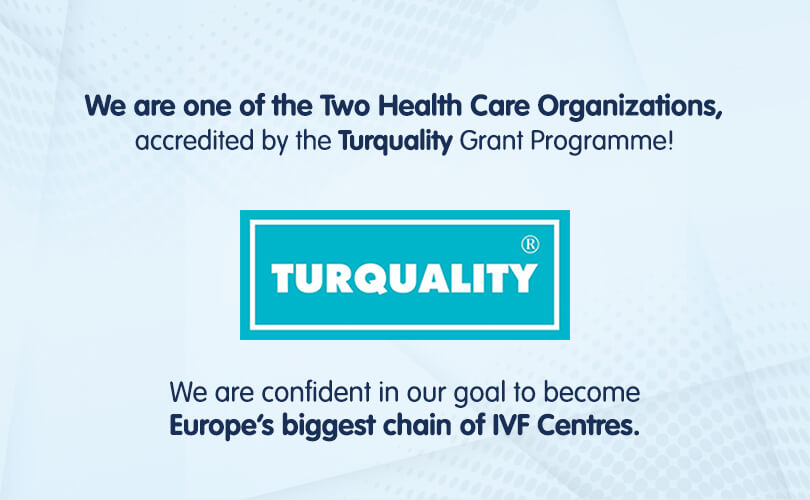What is IVF?
In vitro fertilization is a method of treatment used when couples cannot conceive despite unprotected regular intercourse. For couples to be assessed for infertility, pregnancy should not be achieved despite the following:
– Regular intercourse for a year, for females younger than 35 years of age
– Regular intercourse for six months, for females older than 35 years of age
An IVF treatment is a process that is performed as a result of professional teamwork. A successful outcome requires a professional team consisting of gynaecologists (gynaecologist and obstetricians), urologists, embryologists, nurses, and assistant staff.
How is an IVF treatment performed? What are its different stages?
The stages of IVF are as follows:
1. Stage: Medical Examination
On the first appointment, the causes of infertility are explained to the couple wishing to start treatment. Detailed information is given about the tests to be performed. The presence of both the man and the woman at the first visit is important. When coming to the clinic, the patient should bring the results of all the tests performed so far, a uterine X-ray if there is one, and reports of all previous surgical operations or infertility treatments. Moreover, if there are diseases such as heart disease or diabetes, all relevant information and reports should be brought as well.
There is no need to be on a certain day of your menstrual cycle for the first examination. This assessment can be done on any day. After a detailed gynaecological examination and ultrasonography, additional tests may be required if deemed necessary. When deemed necessary by the physician, examinations with the geneticist, urologist, embryologist, clinical psychologist, and dietician are planned. These experts then assess the general situation of the patient. The goal is first to establish the causes of infertility and to decide on the appropriate treatment for the patient; then, at the appropriate time, to provide the appropriate treatment.
2. Stage: Controlled Ovarian Stimulation
On the second or third day of her menstruation, the prospective mother comes in for an examination, and the doctor assesses the status of the ovaries via ultrasound imaging. Depending on the condition of the patient, the hormone levels on that day can also be looked at. According to the results, the physician prescribes a hormone treatment aiming to stimulate the ovaries of the patient and to produce multiple eggs. The relevant information is given to the patient. The hormone injections, which contain FSH and HMG, regularly stimulate the ovaries to promote the development of a large number of follicles (small sacs which are thought to contain egg cells).
The number of follicles developed directly affects the chances of success of the treatment. For this reason, the starting dose of the hormone injections depends on the age, weight, and previous treatments of the patient.
Follicular development is tracked through the oestrogen level in the blood and the size and count measurements of follicles via ultrasonography. By evaluating these data, the doses of the injections containing FSH and HMG are determined throughout the egg development stage. Following the hormone injections (8-10 days), a trigger injection is given when the largest follicle reaches 18-20 mm in size.
3. Stage: Egg Collection
Approximately 34-36 hours after the trigger injection, the eggs are harvested from the vaginal tract through a brief surgical procedure under general anaesthesia. Egg collection is a painless procedure performed under general anaesthesia. The collected eggs are taken into the laboratory and prepared for microinjection.
4. Stage: Fertilisation in the Laboratory
The eggs are assessed under the microscope in the laboratory. The most suitable ones are fertilised with selected sperms and monitored for embryo development. Two different methods are used for the fertilisation process. In regular IVF procedures, sperm and egg cells are placed in the same medium and fertilisation is achieved when the sperms reach the egg, as they would naturally do. With the microinjection method, the selected sperm cell is injected into the egg using microcannulae. The method to be used in the treatment is determined by evaluating the characteristics of the egg and sperm of the couples, along with their treatment history.
The fertilised eggs are placed in special devices called incubators, which are designed to mimic the uterine environment in the best possible way, and their development is monitored on a daily basis. The daily monitoring aims to help select the highest-quality embryo that is most likely to hold onto the uterus. As in distinguished high-tech laboratories, the Bahçeci laboratories also use a special incubator device that provides dynamic embryo imaging systems during embryo growth, follow-up and selection. With this device, also known as the embryoscope, the embryo can be monitored without any changes to its environment, and thus the selection of the embryo with the highest potential for pregnancy can be performed more accurately and more safely.
5. Stage: Embryo Transfer
This is the shortest but most important stage of the treatment. Failure to correctly transfer the selected embryo or embryos into the uterus can put the entire treatment at risk. For this reason, the experience and knowledge of the doctor performing the transfer are as important as the quality and choice of the embryo. The transfer procedure is usually painless, and anaesthesia is very rarely performed. Depending on the embryo count and development, age of the patient, previous attempts and many other parameters, the transfer is performed 2 to 6 days after OPU (egg collection).
The embryo, now at a certain degree of maturity, is transferred into the uterus with the help of a special catheter.
If there are remaining good quality embryos after the transfer, the couple may choose to freeze them for future use.
6. Stage: Medication treatment after the transfer
After the transfer, the patient is given a medication treatment to help the embryo hold onto the uterus.
7. Stage: Pregnancy Test
12 days after the transfer, a Beta-hCG blood test is performed to diagnose pregnancy.
How to choose an IVF Centre?
When choosing an IVF centre, it is essential to look at the experience of the centre, its technical equipment, and its pregnancy rates. Bahçeci Health Group is a huge family that proved itself with 23 years of experience and over 50,000 healthy IVF babies. We keep fulfilling the dreams of thousands of families with our expert doctors and embryologists, and our state-of-the-art embryology labs.
How much does IVF cost?
Due to the current legislation, we cannot give any price information through our website. For more information on IVF, please fill in our contact form or call us on +90 444 3 949





